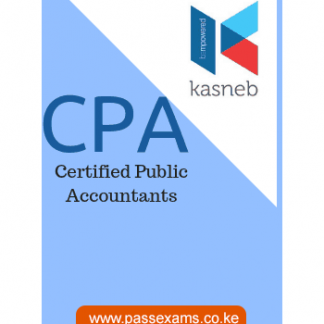Description
Economics CPA Section 2 Notes
Economics CPA Section 2 is a KASNEB foundational course for students. Economics is a useful course for accountants, auditors, investment analysts or advisors, finance managers and financial analysts.
Undoubtedly, we provide the best Economics revision materials, past papers and study notes.
Free download the Economics CPA Section 2 past papers. We have free Economics CPA Section 2 past papers for the new KASNEB syllabus.
Economics CPA Section 2 KASNEB New Syllabus 2021 course has the following topics:
- Microeconomics
- Introduction to economics: Basic economic concepts: economic resources, human wants, scarcity and choice, opportunity cost, production possibility curves/frontiers – Scope of economics: Micro and macro economics – Methodology of economics: positive and normative economics, scientific methods, economics as a social science.
- Demand, supply and determination of equilibrium: Demand analysis, Supply analysis, Determination of equilibrium
- The theory of consumer behavior: Approaches to the theory of the consumer – cardinal versus ordinal approach – Utility analysis, marginal utility (MU), law of diminishing marginal utility (DMU) – Limitations of cardinal approach – Indifference curve analysis; Indifference curve and budget line – Consumer equilibrium; effects of changes in prices and incomes on consumer equilibrium – Derivation of a demand curve – Applications of indifference curve analysis: substitution effect and income effect for a normal good, inferior good and a giffen good; derivation of the Engels curve – Consumer surplus /Marshallian surplus
- The theory of a firm: The theory of production: Short run analysis – Total product, average and marginal products – Stages in production and the law of variable proportions/the law of diminishing returns – Long run analysis – Isoquant and isocost lines – The concept of producer equilibrium and firm’s expansion curve – Law of returns to scale – Demand and supply of factors of production. The theory of costs: Short run costs analysis and size of the firm’s total cost, fixed cost, average cost, variable costs and marginal cost – Long run costs analysis – Optimal size of a firm – Economies and diseconomies of scale
- Market structures: Necessary and sufficient conditions for profit maximisation – Mathematical approach to profit maximisation – Output, prices and efficiency of: perfect competition, monopoly, monopolistic competition, oligopolistic competition
- Macroeconomics
- National income: Concepts of national income: gross domestic product (GDP), gross national product (GNP) and net national product (NNP), net national income (NNI) at market price and factor cost, disposable income – Difficulties in measuring national income – Uses of income statistics – Analysis of consumption, saving and investment and their interaction in a simple economic model – Determination of equilibrium national income – Inflationary and deflationary gaps – The multiplier and accelerator concepts – Business cycles/cyclical fluctuations
- Economic growth, economic development and economic planning
- Money and banking: Money, The banking system: The nature and functions of money – Demand and supply of money – Theories of demand for money: The quantity theory, the Keynesian liquidity preference theory; The role of commercial banks and non-banking financial institutions in the economy – Credit creation – Definition of central bank – The role of the central bank; traditional and changing role in a liberalised economy, such as financial sector reform, exchange rate reform – Monetary policy, definition, objectives, instruments and limitations – Determination of interest rates and their effects on the level of investment, output, inflation and employment – Harmonisation of fiscal and monetary policies – Simple IS–LM Model – Partial equilibrium and general equilibrium
- Inflation and unemployment: Inflation, unemployment: Types and causes of unemployment – Control measures of unemployment – Relationship between unemployment and inflation: the Phillips curve
- International trade and finance: Theory of absolute advantage and comparative advantage – World trade organization (WTO) and concerns of developing countries – Protection in international trade – Regional integration organizations, commodity agreements and the relevance to less developed countries (LDCs)
- Emerging issues and trends
Institute of Economic Affairs-Kenya (IEA-K) and Kenya Institute of Public Policy Research Analysis (KIPPRA) are major bodies of Economics in Kenya.
KASNEB students should adequately prepare for KASNEB CPA Section 2 exams. Additionally, students taking other courses like Certified Secretaries (CS), Certified Credit Professional (CCP), Certified Investment and Financial Analyst (CIFA), among other KASNEB certified courses will find these resources helpful.
KASNEB students have passed their exams while most organizations like colleges have benefited from the resources offered by the Pass Exams Team.
Other units or courses in CPA Section 2 include:
After completion of KASNEB CPA Section 2, the student is well equipped with skills and is on a career path to advancing to CPA Section 3 which has the following units:
KASNEB CPA Section 3 Study notes and past papers are available for the above units.



Reviews
There are no reviews yet.